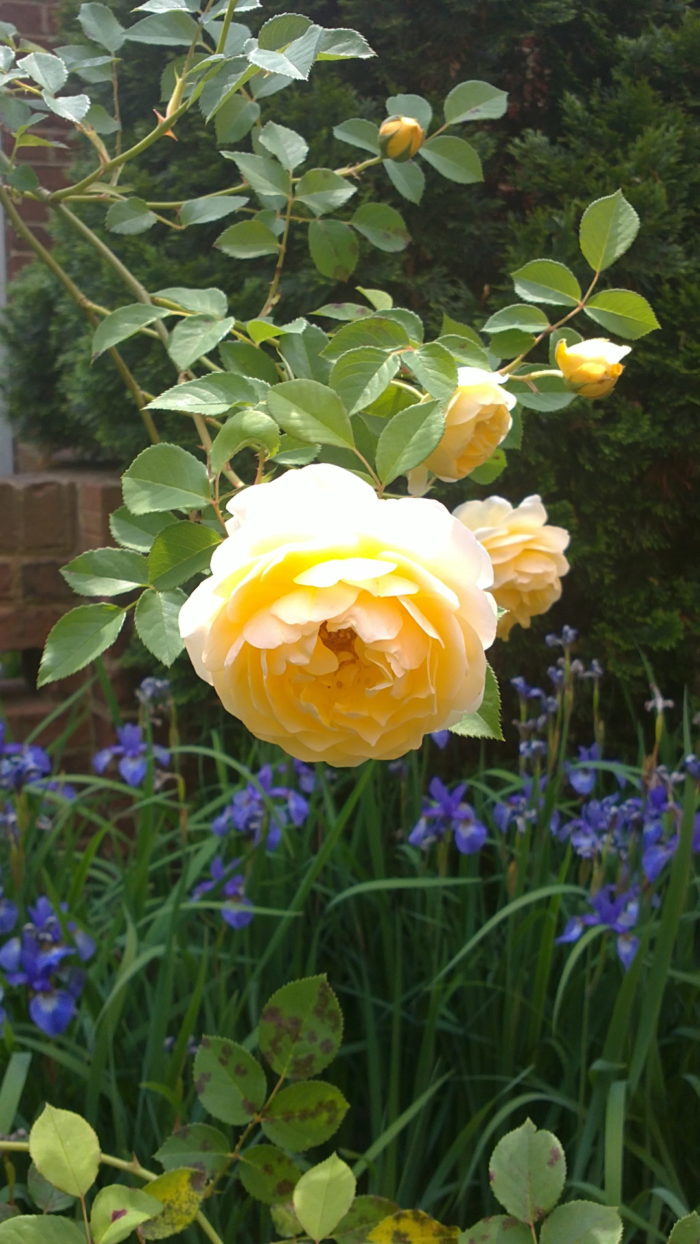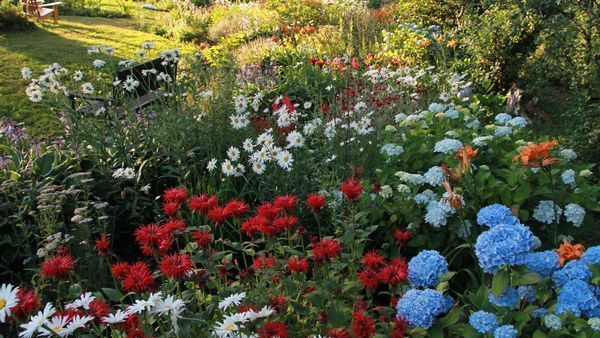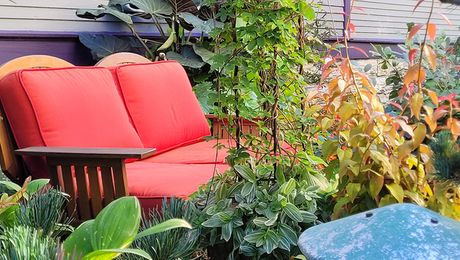Welcome to Kamalika Chakrabarty’s garden.
Our garden in Chapel Hill, North Carolina, consists of a border along the front porch and a side garden that surrounds a patio. We use the garden year-round, and our plantings mirror that year-round purpose. We start the bloom season with peonies and daffodils. Peonies are the easiest of plants to grow. Just plant the bare roots at the end of fall, and in three years you will have so many blooms that there will not be enough flower vases in the house to put them in. Hostas are just peaking out of the ground by midspring. The roses wake up and put out the buds, and the first flush is a beautiful show. Our garden has a mixture of hybrid teas (‘Fragrant Cloud’, ‘Leibeszauber’, ‘Miss All American Beauty’, ‘Elle’, ‘Iceberg’), landscape rose ‘Bonita’, grandiflora ‘Queen Elizabeth’, and old-fashioned English roses (‘Graham Thomas’ and ‘Abraham Darby’).
The roses are planted with contrasting colors. I have paired this yellow ‘Graham Thomas’ rose with a clump of deep blue Siberian iris (Iris siberica,
Zones 2–9). The coral pink of ‘Abraham Darby’ contrasts with the silvery leaves of Artemisia
. Everywhere you turn you can see a little vignette that will bring a smile to your face.
The garden is designed to be a sensory delight, to be enjoyed with all the senses. I have placed wind chimes and bells in certain corners so that a gentle breeze puts forth a soothing sound that feels very peaceful. I have tried planting tulips over the years, but they have turned out to be tasty food for all the critters who visit the garden; hence, I have decided to plant daffodils, which are less palatable. I have fragrant Narcissus that blooms profusely in midspring.
With all the flowers bursting out of their winter slumber, you are guaranteed to get a sumptuous Mother’s Day bouquet!
Our dwarf Japanese maple (Acer palmatum,
Zones 5–9) is twenty-four years old and just 4 feet in height.
These leaves are a beautiful red, and the sun shining through them produces fireworks in the garden fit for a king. The color of the velvety red leaves contrasts very finely with the blue color of the siding.
The hydrangeas bud in midspring. Hydrangeas in our garden bloom from late spring through late summer in shades of pink to blue. I add some aluminum sulfate to the soil to get more blue blooms, because I am partial toward blue.
Our butterfly bushes (Buddleia
spp., Zones 5–9) bloom profusely, but sometimes due to their branching habit they do not mind a sharp pruning in early spring. Several species of butterflies visit us during the flowering season. Lavender and flowering onions (Allium
spp.) are the favorites of bees. Hostas are planted as space fillers and their flowers produce interest in spaces where there are all the shades of green. Other fillers such as creeping phlox, thyme, and daisies are easy to grow and can stand a certain degree of neglect. A flowering jasmine next to the front door is perfectly situated. It comes back year after year without any maintenance requirement. Fragrant lilies and gardenias planted around the front porch can be enjoyed on a quiet summer evening.
Squirrels are frequent visitors to our garden. They love to eat spinach, lettuce, and edible flowers such as nasturtium, but not kitchen herbs such as rosemary, lavender, chives, mint, and basil. In addition, chili peppers and tomatoes do not seem to appeal to these furry friends of ours.
The stalwarts of the winter garden are the camellias. They fill in the spaces where the surrounding shrubs either look a little spent or overgrown. Camellias are ideal to grow in the acidic soil in North Carolina, requiring very little care.
As in all other things in life, one learns from past mistakes. The garden is a perfect example of how we learn what plants survive the four seasons, droughts, negligence, and weeds. The plants in the garden love the sun and are drought tolerant, since in Zone 7 we have hot summers. The heavy layer of mulch does us a great service in reducing weeds and watering needs.
We have turned our patio into a dining area. Our dwarf Japanese maple shields the diners on the patio from the street. We have started experimenting with a blueberry bush and some vegetables such as Malabar spinach. A combination of flowers, vegetables, and butterfly-friendly plants makes it all worthwhile to work in the garden. On some days, we notice more weeds than flowers. On other days, we are grateful for the fruits of our labor. We share the garden and all its pleasures with friends and critters who visit.
Have a garden you’d like to share?
Have photos to share? We’d love to see your garden, a particular collection of plants you love, or a wonderful garden you had the chance to visit!
To submit, send 5-10 photos to [email protected] along with some information about the plants in the pictures and where you took the photos. We’d love to hear where you are located, how long you’ve been gardening, successes you are proud of, failures you learned from, hopes for the future, favorite plants, or funny stories from your garden.
If you want to send photos in separate emails to the GPOD email box that is just fine.
Have a mobile phone? Tag your photos on Facebook, Instagram or Twitter with #FineGardening!
You don’t have to be a professional garden photographer – check out our garden photography tips!
Do you receive the GPOD by email yet? Sign up here.
Fine Gardening Recommended Products
A.M. Leonard Deluxe Soil Knife & Leather Sheath Combo
Fine Gardening receives a commission for items purchased through links on this site, including Amazon Associates and other affiliate advertising programs.
MULTITASKING DUAL EDGES: a deep serrated edge and a tapered slicing edge ideal for tough or delicate cuts. DURABLE 6-inch stainless steel blade withstands 300 lbs of pressure. TWINE CUTTING NOTCH, DEPTH GAUGE MARKINGS & spear point - no need to switch tools when using this garden knife. LEATHER SHEATH: heavy duty, protective, clip on sheath to keep your knife convenient and secure. LIFETIME WARRANTY.






























Comments
Love that Japanese maple!
Sounds like your garden is a great source of joy to you, Kamalika, and your pictures show that you have many beautiful vignettes. It was interesting to read about what plants your visiting squirrels like to nibble on...sounds like you have a good attitude about sharing.
Lovely garden and clever to utilize the growing zone for a year round enjoyment. I envy you that. We have 4-6 months of winter, so a long time to miss the garden. I wanted to share a tip for your bulbs. If you plant your daffodils and tulips together, you may have more tulip success. As you noted, the daffodils are toxic to the critters, so planting the 2 together give a good amount of protection for the tulips. I have done this for numerous years with pretty good success.
What a lovely garden you've created!
I feel very at home looking at your garden. It's so thoughtful the way you have created a living space, dining space outside and share it with natures creatures. I totally relate to what you have done here, the way you speak of the Peonies...the wind chimes to catch the breeze...just lovely. Thanks for sharing your pretty garden.
Log in or create an account to post a comment.
Sign up Log in